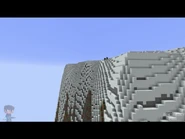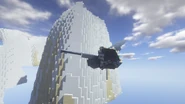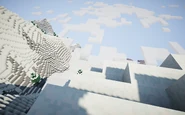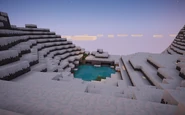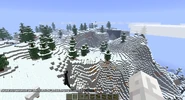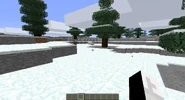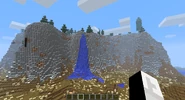(/* Vegetation & Spring Water /*) Tag: Visual edit |
Tag: Visual edit |
||
| Line 17: | Line 17: | ||
The lower part of the Alps generally consists of a very steep upwards incline. The very bottom tends to display a few features from neighboring biomes, with stone and snow eventually replacing them as the elevation increases. |
The lower part of the Alps generally consists of a very steep upwards incline. The very bottom tends to display a few features from neighboring biomes, with stone and snow eventually replacing them as the elevation increases. |
||
| − | With regard to the peaks, there are deep layers of snow with no features whatsoever save for occasional puddles of water. Occasionally, features of Alps Foothills biomes may generate on or near peaks, resulting in the rare appearance of a Fir Tree or Spring Water. |
+ | With regard to the peaks, there are deep layers of snow with no features whatsoever save for occasional puddles of water. Occasionally, features of Alps Foothills biomes may generate on or near peaks, resulting in the rare appearance of a Fir Tree or Spring Water. This is nonetheless, a very impressive biome. |
The Alps soar much higher than the cloud layer, at around y=200, though they are flat on the top. It is a cold biome, water will freeze, and it has snow instead of rain. |
The Alps soar much higher than the cloud layer, at around y=200, though they are flat on the top. It is a cold biome, water will freeze, and it has snow instead of rain. |
||
| Line 24: | Line 24: | ||
The Alps are, of course, incredibly high. Even falling from a peak to the foothills - about two fifths of the total fall - can prove to be deadly. Caves can also be hidden by snow, causing you to fall in if you dig below the snow layer. |
The Alps are, of course, incredibly high. Even falling from a peak to the foothills - about two fifths of the total fall - can prove to be deadly. Caves can also be hidden by snow, causing you to fall in if you dig below the snow layer. |
||
| − | === Vegetation === |
+ | === Vegetation & Spring Water === |
There is no vegetation in this biome, other than subterranean fungi. However: There may be Fir trees scattered around the foothills of this biome or underground Spring Water in the biome itself, if you stand in this it will give you permanent regeneration affect until you leave it. |
There is no vegetation in this biome, other than subterranean fungi. However: There may be Fir trees scattered around the foothills of this biome or underground Spring Water in the biome itself, if you stand in this it will give you permanent regeneration affect until you leave it. |
||
| Line 31: | Line 31: | ||
=== Survival === |
=== Survival === |
||
| − | The Alps biome is a relatively tough biome to survive in. With little to no food sources, and wood being tough to find (trees may grow naturally in the foothills, but once you chop them, they're hard to regrow), the Alps are certainly not a good place to live unless you come prepared. |
+ | The Alps biome is a relatively tough biome to survive in. With little to no food sources, and wood being tough to find (trees may grow naturally in the foothills, but once you chop them, they're hard to regrow), the Alps are certainly not a good place to live unless you come prepared. |
The Alps (of course) are topped by a thick layer of snow. Under the snow is the actual mountain, composed of stone. Small/medium caves can be found, but the only ore you are likely to find is coal (due to the altitude, it will also spawn in very small quantities around 2-5 per vein.). If an Alps Foothills biome generated, you may be able to find some wood from Fir Trees. Small pools of Spring Water may also spawn under the snow or in tiny caves. |
The Alps (of course) are topped by a thick layer of snow. Under the snow is the actual mountain, composed of stone. Small/medium caves can be found, but the only ore you are likely to find is coal (due to the altitude, it will also spawn in very small quantities around 2-5 per vein.). If an Alps Foothills biome generated, you may be able to find some wood from Fir Trees. Small pools of Spring Water may also spawn under the snow or in tiny caves. |
||
Revision as of 04:49, 23 May 2020
The Alps consist of a single mountainous landmass, specifically the base and the highest, flattest part of the area. The upper-middle region of the mountain generally (though not always) consists of an Alps Foothills subbiome, which is an entirely different location in itself.
Description
The lower part of the Alps generally consists of a very steep upwards incline. The very bottom tends to display a few features from neighboring biomes, with stone and snow eventually replacing them as the elevation increases.
With regard to the peaks, there are deep layers of snow with no features whatsoever save for occasional puddles of water. Occasionally, features of Alps Foothills biomes may generate on or near peaks, resulting in the rare appearance of a Fir Tree or Spring Water. This is nonetheless, a very impressive biome.
The Alps soar much higher than the cloud layer, at around y=200, though they are flat on the top. It is a cold biome, water will freeze, and it has snow instead of rain.
Natural Hazards
The Alps are, of course, incredibly high. Even falling from a peak to the foothills - about two fifths of the total fall - can prove to be deadly. Caves can also be hidden by snow, causing you to fall in if you dig below the snow layer.
Vegetation & Spring Water
There is no vegetation in this biome, other than subterranean fungi. However: There may be Fir trees scattered around the foothills of this biome or underground Spring Water in the biome itself, if you stand in this it will give you permanent regeneration affect until you leave it.
Mobs & NPCs
Passive mobs don't spawn in the Alps biome itself, but may spawn in the Alps Foothills and find their way up the mountain. These mobs are primarily Llamas, but sheep can occasionally be found. Hostile mobs spawn all over the Alps at night. In 1.15.2 it seems that snow golems spawn naturally.
Survival
The Alps biome is a relatively tough biome to survive in. With little to no food sources, and wood being tough to find (trees may grow naturally in the foothills, but once you chop them, they're hard to regrow), the Alps are certainly not a good place to live unless you come prepared.
The Alps (of course) are topped by a thick layer of snow. Under the snow is the actual mountain, composed of stone. Small/medium caves can be found, but the only ore you are likely to find is coal (due to the altitude, it will also spawn in very small quantities around 2-5 per vein.). If an Alps Foothills biome generated, you may be able to find some wood from Fir Trees. Small pools of Spring Water may also spawn under the snow or in tiny caves.
The Alps themselves completely lack a food source, but food can be taken from the sheep that occasionally spawn on the foothills. Zombies will also drop Rotten Flesh, so gather them up if you need some extra food.
Mechanics
The primary mechanics of the Alps include its cold weather and generally inhospitable gameplay style. A unique mechanic common to high-altitude biomes is the lack of ores, which is caused by the incredible height of the biome. The presence of Spring Water, which is the rarest liquid in the Overworld, makes up for this severe disadvantage.
Changelog
| Biomes o' Plenty Version | Changes |
|---|---|
| Build 1.7.2-2.0.0.482 | Alps were apparently 'readded'. Original addition date is unknown due to the gaps in the official changelog. |
| Build 1.7.2-2.0.0.801 | The "Alps Forest" sub-biome was added. The biome is not currently in BOP, and it is unknown what has happened to its files. |
| Build 1.7.2-2.0.0.804 | Tweaks and bug fixes |
| Build 1.8-3.0.0.1115 | "Initial Implementation". It is unknown what is meant by this, as earlier changelog versions already mentioned the addition and editing of the Alps. |
| Build 1.8-3.0.0.1118 | "Initial Implementation" (???) mentioned again. |
| Build 1.8-3.0.0.1197 | Emerald generation was added to the Alps. |
| Build 1.8.9-3.0.0.1827 | The amount of snow on the Alps was increased. |
| Build 1.9.4-4.1.0.2043 | The amount of hot springs in the Alps, along with other biomes, was tweaked. |
| Build 1.11.2-6.1.0.2240 | The possibility of the Cold Beach spawning adjacent to the Alps was removed. |
| Build 1.11.2-6.1.0.2248 | The Alps Foothills sub-biome was added. |
Trivia
- In real life, the European Alps are one of the great mountain range systems of Europe. The highest peaks of the Alps are higher than 4,000 meters (the highest peak is the Mont Blanc or Monte Bianco with its 4,810 meters high).
- There is also a mountain range in New Zealand called the Southern Alps, because of the resemblance to the European Alps. It was the filming location of the Misty Mountains scene from the live-action film adaptation of Lord of the Rings: The Fellowship of the Ring.
- Some other biomes can be as high or almost as high (crag, mesa) as the alps biome, though are not covered with snow.
- The Biome ID before 1.8 was 173
- The original appearance of the Alps consisted of a massive landmass crowned by trees and a thin layer of snow. A more recent appearance had thicker snow, and lacked trees. As of the most recent update, the Alps are generally no longer flat; They are more dynamic in height, and tend to have an Alps Foothills biome, yielding a decent supply of wood.
- Due to the regeneration effect caused by the spring water, it is possible to survive nearly anything by simply staying in the water.
Gallery
Current
Old
| Blocks, Biomes, and Items in Biomes O' Plenty (1.20.2)[Show/Hide] | ||
| Overworld Biomes | Aspen Glade • Auroral Garden • Bayou • Bog • Clover Patch • Cold Desert • Coniferous Forest • Crag • Dead Forest • Dryland • Dune Beach • Field • Floodplain • Forested Field • Fir Clearing • Fungal Jungle • Grassland • Highland • Hot Springs • Jacaranda Glade • Jade Cliffs • Lavender Field • Lush Desert • Lush Savanna • Maple Woods • Marsh • Mediterranean Forest • Moor • Muskeg • Mystic Grove • Old Growth Dead Forest • Old Growth Woodland • Ominous Woods • Orchard • Origin Valley • Pasture • Prairie • Pumpkin Patch • Rainforest • Redwood Forest • Rocky Rainforest • Rocky Shrubland • Scrubland • Seasonal Forest • Shrubland • Snowblossom Grove • Snowy Coniferous Forest • Snowy Fir Clearing • Snowy Maple Woods • Tropics • Tundra • Volcanic Plains • Volcano • Wasteland • Wasteland Steppe • Wetland • Wintry Origin Valley • Woodland | |
|---|---|---|
| Nether Biomes | Crystalline Chasm • Erupting Inferno • Undergrowth • Visceral Heap • Withered Abyss | |
| End Biomes | End Corruption • End Reef • End Wilds | |
| Cave Biomes | Glowing Grotto • Spider Nest | |
| Abiotic Blocks | White Sand • (White Sandstone - stairs, slab, wall, smooth, smooth stairs, smooth slab, smooth wall, cut, cut slab, chiseled) • Orange Sand • (Orange Sandstone - stairs, slab, wall, smooth, smooth stairs, smooth slab, smooth wall, cut, cut slab, chiseled) • Black Sand • (Black Sandstone - stairs, slab, wall, smooth, smooth stairs, smooth slab, smooth wall, cut, cut slab, chiseled) • Dried Salt • (Flesh - porous) • Brimstone • Brimstone Fumarole • Block of Rose Quartz • Glowworm Silk • Hanging Cobweb • Stringy Cobweb • Webbing • Brimstone Bud • Brimstone Cluster • Rose Quartz Cluster • Large Rose Quartz Bud • Medium Rose Quartz Bud • Small Rose Quartz Bud • Blackstone Spines • Blackstone Bulb | |
| Biotic Blocks | Origin Grass Block • Rooted Sand • (Flesh - porous) • Toadstool Block • Glowshroom Block • Glowing Moss Carpet • Glowing Moss Block • Spider Egg • Origin Leaves • Flowering Oak Leaves • Rainbow Birch Leaves • Yellow Autumn Leaves • Orange Autumn Leaves • Maple Leaves • (Fir Log - wood, stripped, stripped wood, planks, stairs, slab, fence, fence gate, door, trapdoor, button, boat, chest boat, leaves) • (Redwood Log - wood, stripped, stripped wood, planks, stairs, slab, fence, fence gate, door, trapdoor, button, boat, chest boat, leaves) • (Cherry Log - wood, stripped, stripped wood, planks, stairs, slab, fence, fence gate, door, trapdoor, button, boat, chest boat, pink blossoms, white blossoms) (Saplings - origin, flowering oak, rainbow birch, yellow autumn, orange autumn, maple, fir, redwood, white cherry, pink cherry, mahogany, jacaranda, palm, willow, dead, magic, umbran, hellbark) • Rose • Violet • Lavender • Wildflower • Orange Cosmos • Pink Daffodil • Pink Hibiscus • Glowflower • Wilted Lily • Burning Blossom • Blue Hydrangea • Goldenrod • Willow Vine • Spanish Moss• Sprout • Bush • Clover • Huge Clover Petal • Dune Grass • Desert Grass • Dead Grass • Cattail • Barley • Sea Oats • Reed • Watergrass • Dead Branch • Bramble • Toadstool • Glowshroom • Pus Bubble • Flesh Tendons • Hair | |
| Liquids | Blood • Liquid Null | |
| Items | Rose Quartz Shard • Wanderer • Blood Bucket | |


